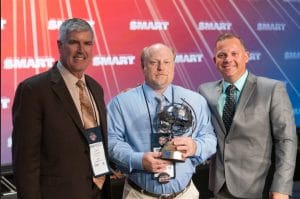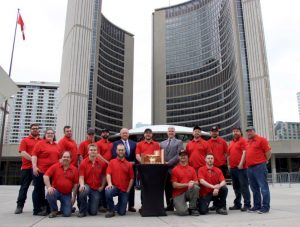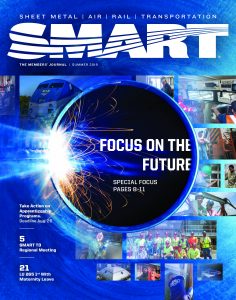Over 300 SMART Local 104 sheet metal workers employed at Simpson Strong-Tie in Stockton, California have been on strike since Thursday, September 5th, 2019. The men and women behind the production of Simpson Strong-Tie’s beloved fasteners, joints and other products are fighting for respect and dignity at work. Please share the social media post in this link to support these members.
Author: paul
With the potential fate of registered apprenticeship programs hanging in the balance, SMART members from across the United States joined their brothers and sisters across the Building Trades in filing comments against the inclusion of Industry Recognized Apprenticeship Programs (IRAPs) in the construction industry.
As part of President Trump’s push to expand apprenticeship programs, the Department of Labor issued a Notice of Proposed Rulemaking in June to encourage more industries to follow the apprenticeship model. While IRAPs would be useful in some industries without active apprenticeship programs, they would devastate industries like construction where these programs have existed and been developed for over 100 years.
IRAPs would grant private organizations like trade associations and employers the power to create their own apprenticeship programs. Unlike current registered apprenticeship programs, these new programs would self-police themselves and be subject to whatever standards the private group sets for itself. These programs would not be regulated to the high standards already set by programs like those set by SMART sheet metal apprenticeships.
Registered apprenticeship programs were designed over the course of decades to recruit, train and retain workers through progressive wage increases while providing transparency in their training and allowing for quality assurance to be maintained through government regulations with mandatory safety training a key feature.
Since IRAPs will not have to follow these same set of rules, they would create a race to the bottom in terms of training and harm industry and workplace standards for everyone involved in the construction industry – that includes not just apprentices but also journeypersons and even retirees who rely on contributions made at a rate set in an industry governed by the high standards set by registered apprenticeship programs.
As of 2019, the combined union construction trades spend $1.6 billion per year to train apprentices and provide upgrade classes for journeypersons looking to enhance their skills and careers. This includes rigorous safety training that keeps jobsites safe in one of America’s most dangerous occupations.
The deadline for comments on IRAPs came on August 26. In all, SMART members submitted just over 18,000 comments to the Department of Labor with several thousand more comments submitted by friends and family members. In total, over 250,000 comments were submitted by Building Trades Unions and allied groups with about one dozen comments in support of the inclusion of IRAPs in the construction industry. The 250,000 comments broke a previous record of 25,000 submitted on changes to overtime pay when a proposal was made by the Bush Labor Department.
As of press time, a final decision on IRAPs has not been made.

Burgin, of Dunlap, Tennessee, serves as SMART Local 5’s Chattanooga-area business representative. He also championed a USA Work Boots on the Ground (WBG) project to enhance access to Tennessee’s Lake Chickamauga—a popular destination for anglers and other watersports enthusiasts from within the state and around the country.
Burgin played a pivotal role in the major overhaul of one of Chickamauga’s busiest access points, the Wolftever Creek Boat Ramp adjacent to Harrison Bay State Park just outside Chattanooga. The renovation expanded year-round access by replacing an existing dilapidated dock with a brand-new, 104-foot-long, handicap-accessible floating pier. Volunteers also restored a fishing pier adjacent to the launch and later hosted a USA Take Kids Fishing Day event at the rejuvenated ramp.
The entire project was conducted without state game and fish funds. Materials were purchased with $10,000 raised by United Auto Workers (UAW) Local 42 and $22,000 in federal marine fuel tax revenues from the Tennessee Wildlife Resources Agency (TWRA). All union labor was donated by volunteers from SMART Local 5, UAW Local 42, IBEW Local 175 and Iron Workers Local 704.
“Jeff was crucial to the Wolftever Creek fishing access project,” said USA Conservation Manager Rob Stroede. “He, along with the apprentices that he leads, donated their time on multiple weekends to see the restoration through to the end. Without his assistance and leadership, the project would have been difficult to complete. Now the renovated pier provides better access to the thousands of anglers and boaters who utilize the boat ramp, as well as to the many anglers who fish from the pier.”
For his part, Burgin said the efforts were a labor of love.
“After hearing Stroede speak about the upcoming project and the USA’s Work Boots on the Ground program at a Chattanooga Area Labor Council meeting, I was hooked and told him that we wanted to help,” Burgin explained. “The USA is spot-on with their efforts to provide union labor with an outlet to serve their communities with meaningful conservation projects that positively impact the environment. I’m thankful to serve and look forward to working with the USA again in the future.”
USA CEO and Executive Director Scott Vance presented Burgin with his award August 15, 2019 at SMART’s Second General Convention in Las Vegas.
The Conservation Steward of the Year selection process begins with the nomination of potential recipients by peers or union leadership. From this pool of nominees, USA staff select individuals who have had the greatest impact on the USA’s mission, represented their unions in the most exemplary fashion, and made the biggest difference in their local community.
As you probably already know, SMART reached an agreement with the Ontario Sheet Metal Contractors’ Association to renew the Sheet Metal ICI Collective Agreement this past week.
All Ontario Local Unions involved ratified the agreement after the strike ended on June 29.
On behalf of the Ontario negotiating team, and every sheet metal worker across Ontario, I would like to extend our sincere thanks and gratitude to every one of our brothers and sisters across SMART. Your comments via email and social media stiffened our resolve through the long eight weeks we spent on the picket line. We cannot name every member and local from across the sheet metal and transportation industries who stood with us, but those who traveled from Philadelphia to walk the picket line with us in Niagara Falls help personify the strength and unity of this Union. Many locals from across the United States and Canada contributed financially as well – and we are eternally grateful for your tremendous solidarity.
The word solidarity has a special meaning to us after what we experienced over the past two months.
Once again, we are thankful for each and every one of our brothers and sisters across the US and Canada who stood with us and be assured that we will be there for you when and if the day comes.
In solidarity,
James Jackson
SMART Director of Canadian Affairs

On Saturday evening the Canadian Council hosted the Apprentice banquet to honour all the apprentices who competed and to recognize those who stood above the rest with awards and cash prizes for 1st, 2nd, 3rd and 4th place along with a special presentation for congeniality for the apprentice found to be most friendly and helpful by his/her fellow competitors. The Canadian Council of Sheet Metal Workers and Roofers wishes to congratulate all the competitors and thanks those help to contribute to making this year one of the best apprentice contest held.
1st Place – John Hannigan award & $750.00 – Greg Holland, Local 30, Toronto, Ontario
2nd place –Ron S Taylor Award & $500.00 – Danielle Fleming, Local 30, Toronto Ontario
3rd place – James Fletcher Award & $250.00 – Dale Mitchell- Local 296, Regina Saskatchewan
4th Place – Bob Brown Award & $250.00 Johnathon Duchesne – Local 397, Thunder Bay Ontario
Congeniality Award – Matthew Squires – Local 512, St John’s Newfoundland

Brother Sonnenschein joined Local 36 in December 1979 and retired from Industrial Sheet Metal, where he worked for 23 years, in 2011. He passed away Dec. 14 after a battle with brain cancer. He would have turned 64 on Valentine’s Day. According to the St Louis Labor Tribune, she called Local 36 the day before his birthday and scheduled a visit with Local 36 Financial Secretary-Treasurer Jeremy Snyder.
Snyder said that “instead of mourning, she wanted to celebrate his birthday by taking coffee and donuts to some of his fellow sheet metal workers.” Snyder and Local 36 Business Representative Chris Brunnert arranged for a visit, and she met with members at the Harris House Inpatient Treatment Center jobsite in St. Charles, Missouri, and at Wiegmann Associates Mechanical Contractors and Engineers in St. Charles.
Photo courtesy of Angie Sonnenschein
On June 4th, SMART General President Joseph Sellers and Assistant to the General President Joseph Powell visited Local 19 members working at the Penn First rack building facility and Wm. J. Donovan’s thermaduct shop in Philadelphia, Pennsylvania. Both men wanted to witness SMART sheet metal workers doing what they do best—fabricate the highest-quality HVAC products anywhere and hear directly from members about their concerns and ideas regarding the state of the Union.
The first stop was the rack assembly facility that Local 19 signatory contractor Southland has set up in West Philadelphia. GP Sellers and Powell toured the facility along with Local 19 President Gary Masino and Assistant Business Manager Jerry Gontz. The shop is housed in what used to be a massive steel plant with plenty of room for all the trades to work. SSM Industries is on site with 10 members working to assemble the duct components in the racks.
Brother Ed Sparks, the Local 19 steward on site, explained how the installation process worked much like an assembly line to maximize efficiency and quality. The racks in question are mechanical rack systems that range in size from 11 feet by 5 feet to 18 feet by 8 feet. Each trade assembles and places components in the racks in a specific position as per the jobsite prints. The wheeled racks get rolled between the different sections of the shop. The sheet metal workers assemble the duct that is specific to each rack, then the insulator wraps the duct that is then it is placed in the rack. After that, the rack is rolled over to one of two fitting companies on site and the fitter adds their pipe, as does the plumber. After the top is welded on to the rack, it is held in storage until needed in the field.
When the racks are sent out to the field, they are loaded onto trucks with the wheels still attached, then transported to the Penn First Jobsite and craned up to the floor where they are to be installed. When reaching the floor, they are rolled into place, raised into position and hung where all the mechanical components line up with the components in the previous rack within the ceiling space. All that is left is to connect the two racks with a filler piece and the rest of the pieces that tie into the system. After the racks are hung, the wheels are removed and sent back to the shop to restart the process. Brother Farrall MISSING FIRST NAME mentioned that this method of construction has been very beneficial out in the field. Not only does it facilitate a quick install, it also takes much of the staging materials onsite out of the equation. Penn First is the first project in Local 19’s territory to utilize this racking method and it has been very successful so far on the Penn First Project.
Next, the group headed over to Wm. J. Donovan for a short discussion and presentation of how Thermaduct is fabricated and how it will benefit our industry into the future. Shear Facts had a previous article on the new exterior duct product in 2018. Since that article, Wm. J. Donovan has fabricated numerous Thermaduct systems for other signatory contractors and have even installed a few itself. A group of Wm. J. Donovan’s upper management along with shop Foreman Mike DelGiorno and shop Steward Fred Stock met with SMART officials and walked them through the process of fabricating, the many benefits to the product including that the systems (when installed properly) are water tight, will last through all the elements and are a third of the weight compared to traditional exterior double-walled duct systems.
After the brief introduction to the product, the group headed to the fabrication shop across the street. When walking through the door it looks like any other fab shop, with material organized and stacked. But farther into the space, you start to notice this shop isn’t like many others in our trade. Straight duct and fittings are there throughout, but they’re a bit different than what most sheet metal workers are accustomed to with a poly-vinyl coating on the outside and what looks to be foil on the inside. Toward the back wall, you’ll see what looks like a plasma table with a long tube running from the mechanical arm to a canister. Over to the left there seems to be what resembles a brake. So as far as equipment is concerned, this shop doesn’t need much to function.
Local 19 members Brandon Steigerwald and Matt Watkins were on hand to give a tour on how Thermaduct is produced. Directly next to the table where the sheets are cut out there is a stack of Thermaduct sheets. On closer inspection, one can see that the sheets are essentially solid core insulation (similar to roof insulation) with a polyvinyl side while the other side has a foil material. Steigerwald and Watkins take a sheet over to the table, set the coordinates and let the machine do its work. The arm moves around and begins to route lines into the material on the foil side and then proceeds to cut an outline around the entire half section. After the machine finishes the process, Steigerwald takes the piece over to what is known as a thermal brake, which is used for bending the pieces just cut by heating up to anywhere between 325 and 375 degrees (depending on the surrounding temperature) and melting the vinyl coating on the material to where it is pliable enough to bend the piece into place.
After the sections are bended on the thermal brake, they are connected on each end, a flange product is affixed, stiffening rods added (as needed) and all seams are caulked. When installing in the field, an added layer of vinyl is added to surround where the connections are to ensure the product is completely water tight.
There are also added benefits to Thermaduct over traditional exterior systems aside from the weight and waterproof features. Because how it is constructed there is little to no deflection when the system becomes live. This means the duct isn’t moving or shifting as it would with a traditional system. This is a benefit because typically when there is defection, that movement of the duct (in or out) may loosen the insulation on the inside, with a possibility of the insulation finding its way into the airsteam.
The Thermaduct system is self-contained where deflection isn’t an issue, and these systems can withstand pressures of 10 in (plus or minus) water gauge. Wm. J. Donovan is a licensed fabricator of Thermaduct systems, serving Pennsylvania (east of Pittsburgh), South Jersey, parts of North Jersey, Delaware and the tip of Maryland.
The future possibilities for the next generation of sheet metal workers is seemingly endless with constant new technologies emerging every year. Our members will be there at the forefront of every innovation, ready to learn every new method and skill needed to continue to be the most knowledgeable, safe and valuable workers in the construction industry
Union Plus recently awarded $170,000 in scholarships to 108 students representing 34 unions, including two winning family members from SMART. This year’s group of scholarship recipients includes university, college, and trade or technical school students from 31 states plus the District of Columbia. The SMART winners are:
- Anika Daniels-Osaze, Ph.D., of Brooklyn, New York. Daniels-Osaze, whose father, Richard Daniels, is a member of SMART Transportation Division Local 645. She was awarded a $1,500 scholarship.
- Sofia de Leon of Lakewood, Washington. De Leon, whose mother, Michelle Wilson, is a member of SMART Local 66 in Seattle. She was awarded a $1,000 scholarship.
The application is entirely online, allowing students to complete their application over time and save their responses. Over the past 28 years, more than $4.5 million have been awarded to students of over 3,000 union families. Start your application today! Deadline: January 31, 2020 | www.unionplus.org/scholarship
